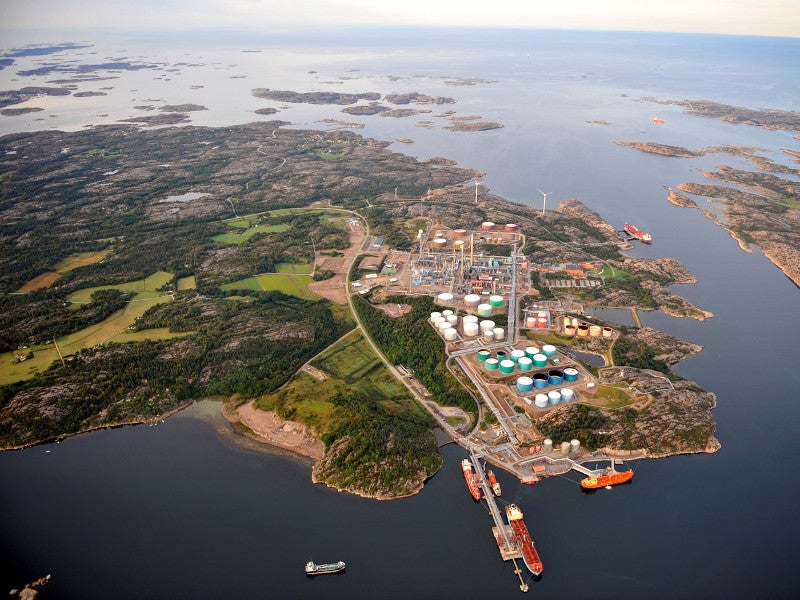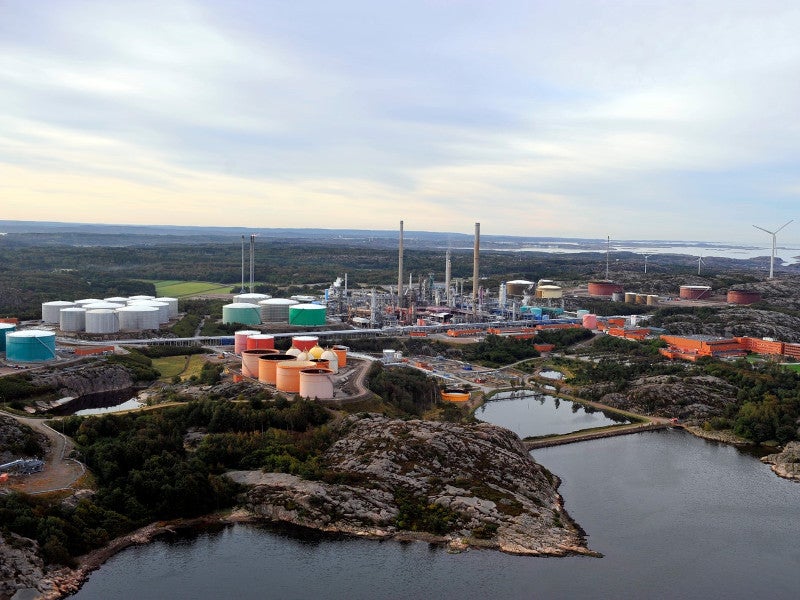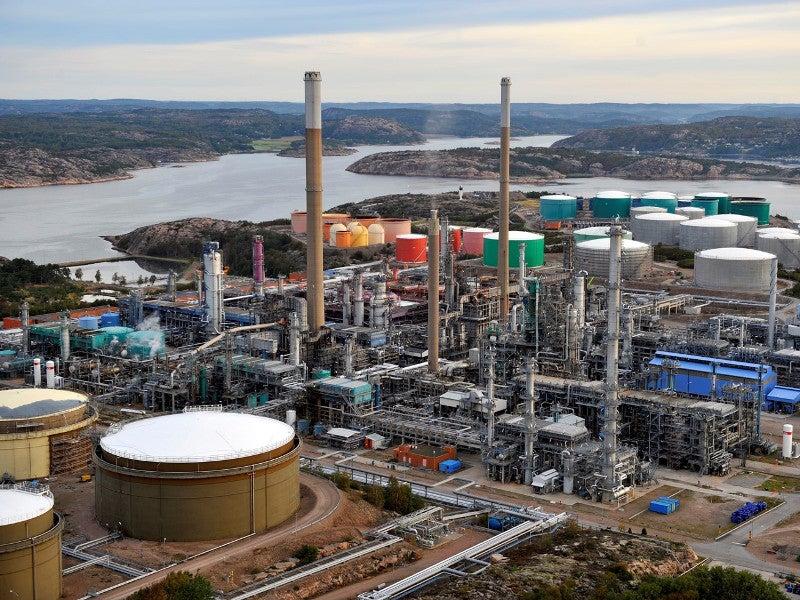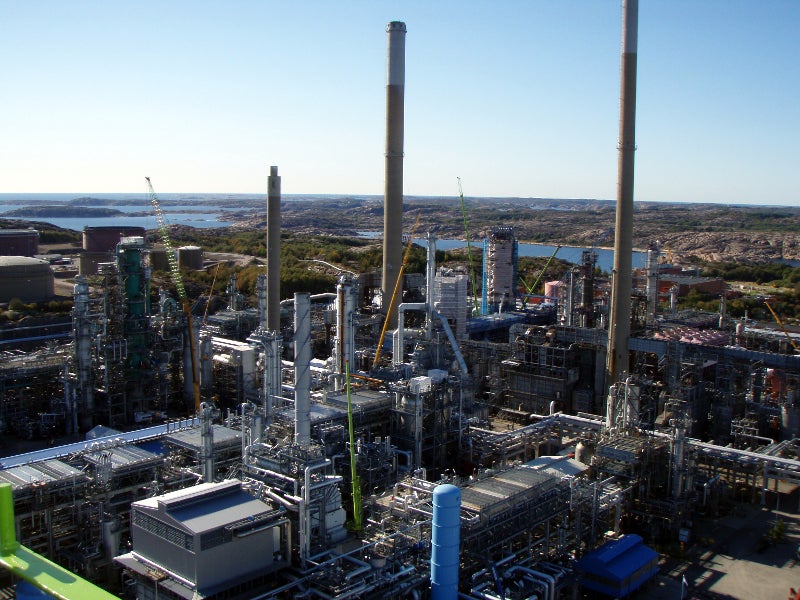The Preemraff Lysekil refinery, formerly known as the Scanraff oil refinery has been operational at Lysekil, on the west coast of Sweden, since 1975.
Capable of processing 220,000 barrels per day (bpd) of crude, it is currently the biggest oil refinery in Sweden, as well as in the entire Nordic region.
Innovative measures are being taken to ensure long-term, sustainable operation of the refinery in compliance with new environmental rules.
The Preemraff Lysekil refinery is planned to be added with a residue oil conversion complex (ROCC) to produce 100% ultralow-sulphur products from its vacuum residue.
The front-end engineering design (FEED) phase for the ROCC project commenced in January 2020.
Studies are also underway for a carbon capture and storage (CCS) project at the refinery.
Owner and operator details
The Lysekil refinery facility is owned and operated by Preem, a wholly-owned subsidiary of Saudi billionaire Mohammed Hussein al-Amoudi’s Corral Petroleum Holdings.
Preem is Sweden’s largest petroleum company that controls approximately 80% of the country’s total refinery capacity. It took full control of the Lysekil refinery by buying a 25% stake held by Norsk Hydro in 2003.
The company also operates another refinery in Gothenburg and has an aggregate refinery capacity of 345,000bpd. Approximately two-thirds of the total refinery products from both the sites are exported to north-western Europe.
Location and site details
The refinery is located at Brofjorden near Lysekil, approximately 130km north of Gothenburg, the second-largest city in Sweden.
The refinery sits on a 465acre-site adjacent to the port of Brofjorden, which is also owned by Preem.
Preemraff Lysekil refinery performance
The Preemraff Lysekil accounted for approximately 50% of the total refining capacity in Sweden in 2018.
The refinery has a Nelson Complexity Index (NCI) of 10. It produces a range of products including liquefied petroleum gas, petrol, diesel, heating oil, and fuel oil.
It processed 79 million barrels of crude in 2018, up from 77.4 million barrels in the previous year.
Sour crude oil accounted for approximately 63% of the total crude oil processed by the refinery during 2018.
The gross refining margin of the Preemraff Lysekil refinery averaged $5.79 per barrel in 2018.
Processing infrastructure at Preem’s Lysekil refinery
The refinery has underground crude oil storage caverns with a total storage capacity of 8.5 million barrels as well as day tanks with an aggregate storage capacity of one million barrels.
The primary processing facilities at the refinery comprises an atmospheric distillation unit, as well as a vacuum distillation unit (VDU) that was installed in 2019 to process heavier distillates obtained from the crude distillation process.
The upgrading units at the refinery include a visbreaker unit, a fluid catalytic cracker (FCC) unit, a mild hydrocracker (MCH) unit and a hydrocracker unit.
The Visbreaker unit was installed in 1982 followed by the installation of the FCC unit in 1984.
The MHC unit was added in 1988, while the hydrocracker unit was installed to convert vacuum gasoil to lighter, higher-value products in 2006.
The refinery was also fitted with a diesel desulphurisation unit in 1994 to reduce the sulphur content in diesel to 10ppm.
The Lysekil refinery complex also houses an isomerization unit installed in 1994 to process naphtha into high-octane and low-benzene petrol blending components, and a propylene recovery unit installed in 2002 to remove propylene from the liquefied petroleum gas produced by the FCC.
Preem completed a £48m ($79m) refurbishment programme to maintain safe and reliable operations of the refinery in 2013.
Residue oil conversion project
In January 2020, McDermott International was granted approval to proceed with the FEED works for the residue oil conversion (ROCC) project to be implemented at the Lysekil refinery.
The ROCC project is intended to produce sulphur-free gasoline and diesel from the heavy crude residue of the refinery using Chevron Lummus Global’s (CLG) LC-SLURRY high conversion residue hydrocracking technology.
CLG is a joint venture between Chevron and McDermott (formerly CB&I).
The ROCC project is being jointly undertaken by Preem and Beowulf Energy, an energy infrastructure project developer based in the US.
Preem and Beowulf Energy signed a cooperation agreement for the use of LC-SLURRY technology at the Lysekil refinery in May 2016, while Beowulf Energy signed a technology license agreement for the same with CLG in 2017.
McDermott also executed pre-FEED works for the project in 2017 and was the engineering, procurement, construction, and management (EPCM) contractor for the hydrocracker unit that was added to the refinery in 2006.
Carbon capture initiative
Aker Solutions was contracted by Preem to conduct a feasibility study for a carbon capture facility at the refinery in February 2019. The scope of the contract also included pilot tests to capture carbon dioxide from flue gas emissions of the refinery.
Preem, in collaboration with Chalmers University of Technology and the Norwegian research institute SINTEF had completed a preliminary study for a carbon capture and storage (CSS) facility at the Lysekil refinery in 2018.
The preliminary study was supported by The Swedish Energy Agency and Norway’s state enterprise Gassnova.






